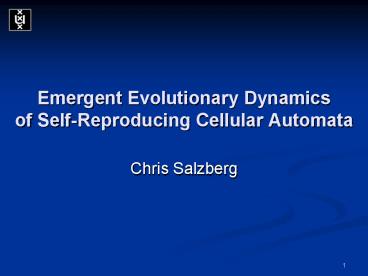Emergent Evolutionary Dynamics of SelfReproducing Cellular Automata PowerPoint PPT Presentation
1 / 33
Title: Emergent Evolutionary Dynamics of SelfReproducing Cellular Automata
1
Emergent Evolutionary Dynamics of
Self-Reproducing Cellular Automata
- Chris Salzberg
2
Credits
- Research for this project fulfills requirements
for the - Master of Science Degree - Computational Science
- Universiteit van Amsterdam
- Project work conducted jointly with Antony Antony
(SCS) - Supervised by Dr. Hiroki Sayama
- (University of Electro-Communications, Japan)
- Mentor Prof. Dick van Albada
3
Lecture Plan
- Context History
- Self-reproducing loops, the evoloop
- A closer look
- New method of analysis
- Genetic, phenotypic diversity
- New discoveries
- Mutation-insensitive regions
- Emergent selection, cyclic genealogy
- The evoloop as quasi-species
- Conclusions
4
Context
- Artificial Life
- Study of life-as-it-could-be (Langton).
- Emphasizes bottom-up approach
- synthesize using e.g. cellular automata (CA)
- study collective behaviour emerging from local
interactions (complex systems) - Artificial self-reproduction
- abstract from the natural self-reproduction
problem its logical form (von Neumann)
5
A brief history
Chou Reggia (emergence of replicators)
Morita Imai (shape-encoding worms)
John von Neumann
Imai, Hori, Morita (3D self-reproduction)
2003
1970
1984
1989
1950s
1996
First international conference on Artificial Life
Suzuki Ikegami (interaction-based evolution)
Conways Game of Life
Langtons SR Loop
Sayama (SDSR Loop, Evoloop)
6
Self-reproduction in Biology
- Traditionally (pre-1950)
- Self-reproduction associated with biological
systems of carbon-based organisms. - Research limited by variety of natural
self-replicators. - Problem of machine self-replication discussed
purely in philosophical terms.
7
Theory of self-reproduction
- John von Neumann (1950s)
- First attempt to formalize self-reproduction
- Theory of Self-Reproducing Automata
- Universal Constructor (UC)
- Cellular Automata (CA) introduced (with S. Ulam).
- This seminal work later spawns the field of
Artificial Life (late 1980s).
8
The Universal Constructor
- Universal Constructor (1950s)
- 29 state 5-neighbour cellular automaton.
- Capable of universal construction.
- Predicts separation between genetic information
and translators/transcribers prior to discovery
of DNA/RNA.
9
Separation for evolution
P r-b-r-y
C r-b-y-y
- Separation is necessary for evolution
- Self-description enables exact duplication.
- Modified self-description (by noise, etc.)
introduces inexact duplication (mutation).
10
UC-based replication Loops
- Loop structure used to represent a cyclic set of
instructions. - Langton (SR Loop), Morita Imai, Chou Reggia,
Sayama, Sipper, Suzuki Ikegami - Self-replication mechanism dependent on
structural configuration of self-replicator.
11
The self-reproducing loop
genes
sheath
arm
tube
- Sheath Outer shell housing gene sequence.
- Genes 7s (straight growth) and 4s (turning).
- Tube core (1) states within sheath.
- Arm extensible loop structure for replication.
12
The evolving SR loop (evoloop)
- A new self-reproducing loop by Sayama (1999),
based on SR Loop (Langton, 1984) - 9-state cellular automaton.
- 5-state (von Neumann) neighbourhood.
- Modifications to earlier models (SR, SDSR) enable
adaptivity leading to evolution. - Mutation mechanisms are emergent.
13
Evolutionary dynamics
8
- Continuous reproduction leads to high-density
loop populations - Evolution ends with a homogeneous, single-species
population - Evolutionary dynamics seem predictable.
7
6
5
4
14
Hidden complexity?
- Emergent evolutionary dynamics demand
sophisticated analysis routines. - Original methods use size-based identification
only. - Missing structural detail
- gene arrangement and spacing
- genealogical ancestry
- Computational routines highly expensive.
15
A closer look
w
phenotype
l
genotype
- Loops composed of phenotype and genotype
- Phenotype inner and outer sheath of loop
- Genotype gene sequence within loop
- Define loop species by phenotype genotype.
- Sufficient information for loop reconstruction.
16
Parallels to biology
remnants
dynamic structures
- The evoloop is a messy system
- replication is performed explicitly
- mutation operator is emergent
- interactions (collisions) produce remnants of
inert sheath states and anomalous dynamic
structures - Birth and death must be externally defined.
17
Birth detection
Umbilical Cord Dissolver (6)
phenotype
w
l
genotype
18
Scan-layer tracking
umbilical cord dissolver
Loop Layer
to parent loop
Scan Layer
footprint
19
Death detection
Dissolver state
Scan layer I.D.
20
Labeling scheme
growth
turning
core
G
T
C
G
C
C
C
C
G
G
G
G
G
C
G
C
G
T
T
GGGGCGCGTTGCCCCG
21
How many permutations?
(n-1) free Gs
TG
T
n
(n-2) free Cs
- Constraints for exact (stable) self-replicators
- 2 T-genes, n G-genes, (n-2) C-genes.
- T-genes must have no G-genes between them.
- Second T-gene directly followed by G-gene.
22
Genetic state-space
- For a loop of size n, there are different
gene permutations resulting in exact
self-replicators (stable species). - Do gene these permutations affect behaviour?
23
Phenotypic diversity
1000
2000
3000
4000
24
Population dynamics
25
Emergent mutation
GCCCCGGGTTGG GCCCCGGGTTGGGCCCCGGGTTGGGCCCC
GTTGGGCCCCGGGC GTTGGGCCCCGGGCGTTGGGCC
CCG GGGCGTTGGGCC GGGCGTTGGGCCGGGCGTTGGGC
CGGGCG GGCCGGGCGTTGCC GGCCGGGCGTTGCCGGCCGGGCGTTG
CCG GCCGGGCGTTGCCG
(a)
(a)
(b)
(b)
(c)
(c)
(d)
(d)
26
Fitness landscape
- Evolution to both smaller and larger loops
occurs. - Smaller loops dominate
- higher reproductive rate
- structurally robust
- Fitness landscape balances size-based fitness
with genealogical connectivity.
27
Graph-based genealogy
Loop Size
28
Mutation insensitive regions
GGGGCGC GCCTCCTG G
- Certain gene subsequences are insensitive to
mutations - GCTCTG
- These subsequences force a minimum loop size.
- Evolution confined to non-overlapping subsets of
genealogy state-space.
29
New discoveries
- Long-term genetic diversity
- System continues to evolve over millions of
iterations. - Selection criteria not exclusively size-based for
species with long subsequences. - Complex evolutionary dynamics
- Strong graph-based genealogy.
- Genealogical connectivity plays more important
role in selection.
30
Convergence to minimal loop
1
2
3
4
5
6
31
Cyclic genealogy
32
Observations
- Fitness landscape
- fitness ? reproduction rate
- genealogical connectivity (cycles)
- self-generated environments (remnants) ?
- Stable state is reached with dominant species
nearest relatives. - Similar to quasi-species model of Eigen,
McCaskill Schuster (1988).
33
Conclusions
- Simple models may hide their complexity
- graph-based genealogy
- mutation-insensitive regions
- emergent selection (self-generated env.)
- Sophisticated observation and interpretation
techniques play critical role. - Complex evolutionary phenomena need not require a
complex model.

